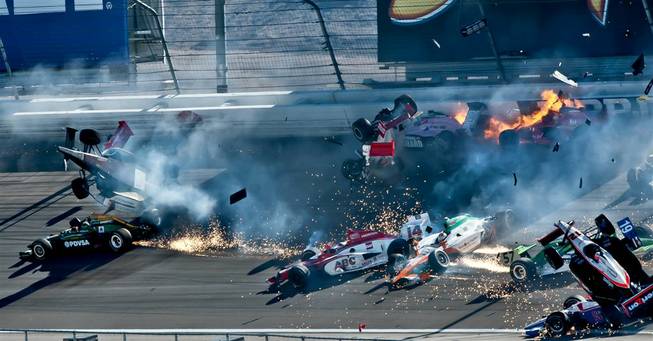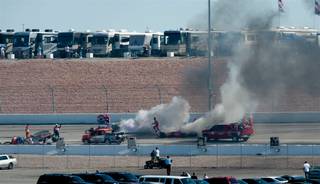
Tom Donoghue/DonoghuePhotography.com
A scene from the 11th lap of The Izod IndyCar World Championship at Las Vegas Motor Speedway on Oct. 16, 2011, where 33-year-old Indianapolis 500 winner Dan Wheldon died in a 15-car crash.
Tuesday, Feb. 14, 2012 | 12:12 p.m.
Sun Coverage
- Tragic day at Las Vegas Motor Speedway (10-16-2011)
- Indianapolis 500 winner Dan Wheldon dies after Las Vegas wreck (10-16-2011)
- Coroner: IndyCar driver Dan Wheldon died of head injuries (10-17-2011)
With the IndyCar Series still recovering from Dan Wheldon's death, race director Beaux Barfield said double-file restarts would be scrapped at Indianapolis, Texas and Fontana and more changes to improve safety could be announced before next month's season-opener at St. Petersburg.
"Oh yeah, there will be lots more to come," Bernard said Tuesday after the two-day state of the series summit wrapped up in Indianapolis.
Bernard didn't provide hints about what other announcements are pending.
It's all part of a plan to make courses safer and revamp IndyCar's image after two-time Indy 500 winner Dan Wheldon was killed in an accident at last year's season-finale in Las Vegas. The wreck pushed safety issues to the forefront of racing and gave the drivers who risk their lives more latitude in framing complaints.
Plenty of changes have already been made.
The series is introducing its first redesigned car in nine years, a model that is being deemed IndyCar's safest yet. Driver seats will be surrounded by three inches of foam in the cockpit, an inch of foam underneath the seat and a panel on the right side of the cockpit to help reduce the force when hitting outside walls. Wheldon, who did most of the early testing, spoke glowingly about the new safety features.
Series officials are hoping the addition of rear-wheel pods will eliminate the wheel-to-wheel contact that can send cars airborne, too.
The 16-race schedule includes only five oval races, a move many racers have embraced since Wheldon's crash though Bernard said that decision was more about marketability than safety with the obvious exception of Las Vegas.
And Barfield, who replaces Brian Barnhart in race control, made his decision after talking directly with the drivers.
"I could look into their eyes and see very legitimate concerns," he said.
When Bernard brought the double-file restarts, a popular NASCAR feature, to the IndyCar circuit last season, those with stock car experience such as three-time defending champ Dario Franchitti and Danica Patrick balked immediately about the dangers it would pose.
Bernard responded by instructing his drivers, which the series calls the world's most versatile, to make it work. After a dubious start in St. Petersburg, they did.
Barfield said he made his decision for two reasons: where the acceleration point is on the track and driver complaints.
It's still possible the double-file restarts could return everywhere in 2013 after series officials evaluate the performance of the new cars, but at least drivers feel like they're getting a say.
"It's an ongoing process and you're not going to fix everything overnight," 2004 IndyCar champ Tony Kanaan said when asked about the new safety measures Monday night. "I'm proud of the communication we've had between the drivers and IndyCar, but it wasn't just that aspect, either. We didn't talk among ourselves (drivers) very good, either."
A handful of drivers, including two of Wheldon's closest friends _ Kanaan and three-time defending points champ Dario Franchitti, promised to change that following Wheldon's funeral.
By building a consensus, series officials are paying more attention to all of the drivers' complaints, not just on safety matters.
The series also announced Tuesday it would no longer use the blind draw to establish lineups this season and would instead experiment with three 30-lap qualification heats at Iowa. The 10 fastest cars in practice will run against each other in the first heat and will take the top 10 starting spots.
Franchitti contended his poor starting spot in the second of twin races at Texas last summer cost him valuable points and could have cost him the championship.
"I think this is different because it's actual competition that will determine the start order, not a blind draw," Bernard said. "Looking in hindsight, it was probably a mistake doing a blind draw."
What more can be done to make IndyCar racing safer?
Ryan Hunter-Reay thinks it's time to make the catch-fences safer. Two-time series runner-up Will Power believes it's time to cover the open cockpits and protect the head.
Apparently, it's all up for debate.
"It's not something that happens with a snap of the fingers," Franchitti said. "But anything we've put on the table, they've listened to and they're working toward it."

